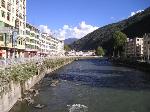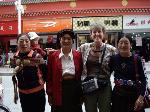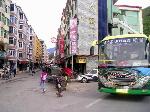- Getting around Lijiang. Dont stay in the Old Towns more than 2 days, there is nothing to do. KRISS Oct 9, 2013 05:46
- 2013 Beijing Temple Fair BENNYLAU Feb 26, 2013 03:29
- Malaysian traveling from KUL - LAX vis Shanghai PVG ZATI_DY Jan 3, 2013 20:15
Crossing Paths with Mao_Maerkang
- Views: 4627
- |Vote: 0 0
- |Add to Favorites
- |Recommend to Friends
The mountainsides press in - steeper with each bend in the road and the valley deepens. The narrow well-patched road hugs the rivers every twist and turn. The scenery is stunning with ever increasing sprays of colour - the delicate creams, pinks and lilacs of spring flowers woven into a blanket of soft limes and russet hues of new foliage amidst the evergreen bamboos. We have left behind the broad flat valley beneath the highland pass draped in its cloak of overnight snow and descended deep into the beautiful Suomo River valley.
Mao’s infamous Red Army - perhaps less than 100,000 strong at the time - marched from the opposite direction up this valley long before there was a road. My travels have led me across their now well known path on several occasions and I can’t help but marveled at the tenacity and courage of the men. The Red Army’s march westward was a slow and torturous trek and the army spent almost a year hidden in the protective folds of these towering mountains. Sadly, thousands perished, if not casualties of the conflict they succumbed to harsh conditions, poor rations, rugged terrain and that last bitter winter as the Army pushed north.
Mao and his generals, including Zhu De and Zhou Enlai were quartered in a small village several kilometers from Maerkang which is not particularly famous but it ought to be. Maerkang was first and foremost the religious centre for the Jiarong Tibetans searching for paradise and the name means something like vigorous flame in the treasured place. Today it is the county seat of Aba, an Autonomous Tibetan Region still rather isolated, buried deep in the foothills of the Tibetan Plateau. Cut off by distance and bad roads Maerkang attracts few visitors apart from out of town Tibetans headed for the ‘big smoke’ and a handful of foreigners enroute to destinations elsewhere.
Had I listened to the Lonely Planet review or worse still that of a young third generation ‘local’ I also should not have come this way. Stopped at road works one day outside Chengdu several years ago my friend asked a group of young Americans we met. ‘Why do you want to go there?’ Their answer surprised her and piqued my interest enough that if I was ever likely to pass through that way I would at least stop and have a look. I have not been disappointed.
Straddling the Suomo River the small city is an eclectic mix of old and new and a melting pot of small mostly Tibetan minorities. Traditional stone block homes hug the hilltops overlooking the newer buildings along the valley floor. We flit from door to door, window shopping, looking at souvenirs and snacking on the tasty local flat breads. I search for the beautifully hand embroidered head wear that many of the older generations still wear. Brightly coloured flowers, fruit and butterflies are some of the themes stitched upon a background of black. This hand woven fabric is then folded into a smaller rectangle which is bound with long woolen plaited ties and braided hair.
Heavy set men and women with striking features, ruddy wind burned cheeks and stunning eyes follow us with unblinking gaze as we pass along the narrow streets, browse in stores and wander through the markets. These dark skinned women are adorned with the bright silver and orange and turquoise jewelry - rings, heavy earrings, long necklaces and broad belts. Their wardrobe is also an eclectic mix of both modern and traditional. Women from different villages and regions are identified by the colours and embroidered designs of their head wear which vary greatly although they may live quite close to one another. Like many of the other cities and towns we have visited in Aba County both locals and visitors are curious and friendly.
Men traditionally wear the long woolen greatcoat with the extra long sleeves, a felt hat and leather boots and often carry a knife from their belts. Many of the small shops in town sell woolen fabrics, clothing, rugs and prayer flags, incense and the white Tibetan friendship scarves. Much of the local produce comes from that very versatile long haired Yak with wool, hide, milk and meat the mainstays of the Tibetan lifestyle and culture. Yak wool socks, sweaters and coats are a bargain along side the cashmere scarves for women. The trophy hunter may prefer an exquisitely ornamented silver and jewel studded yak skull with horns to adorn the walls of the den.
While time marches relentlessly on, change has come slowly to Maerkang and in the villages it would almost seem not at all. Whether on a quest to follow in Mao’s footsteps or just looking for something quiet and more authentic, then a guesthouse in Zhuokeji is in my opinion the best option
Getting There:
By bus from Chengdu (8hrs+), Hongyuan (6hrs), Danba(3/4hrs) and Kanding
A local bus runs east/west between the two villages of Zhuokeji and Songgan, either side of the city and both are worth a visit Y10 each way (refer reviews).
It’s possible to flag down long distance buses for jaunts a little further a field. There are many more small villages and temples around Maerkang although none are easy to get too. There also appears to be a temple of some note up the valley between Zhuokeji and Xiaojin although we did not join the group on a recent visit.
Accommodation: Hotels in Maerkang are plentiful and using the city as a base is a good option for exploring the surrounding villages.








 Copyright © 1998-2026 All rights reserved.
Copyright © 1998-2026 All rights reserved.